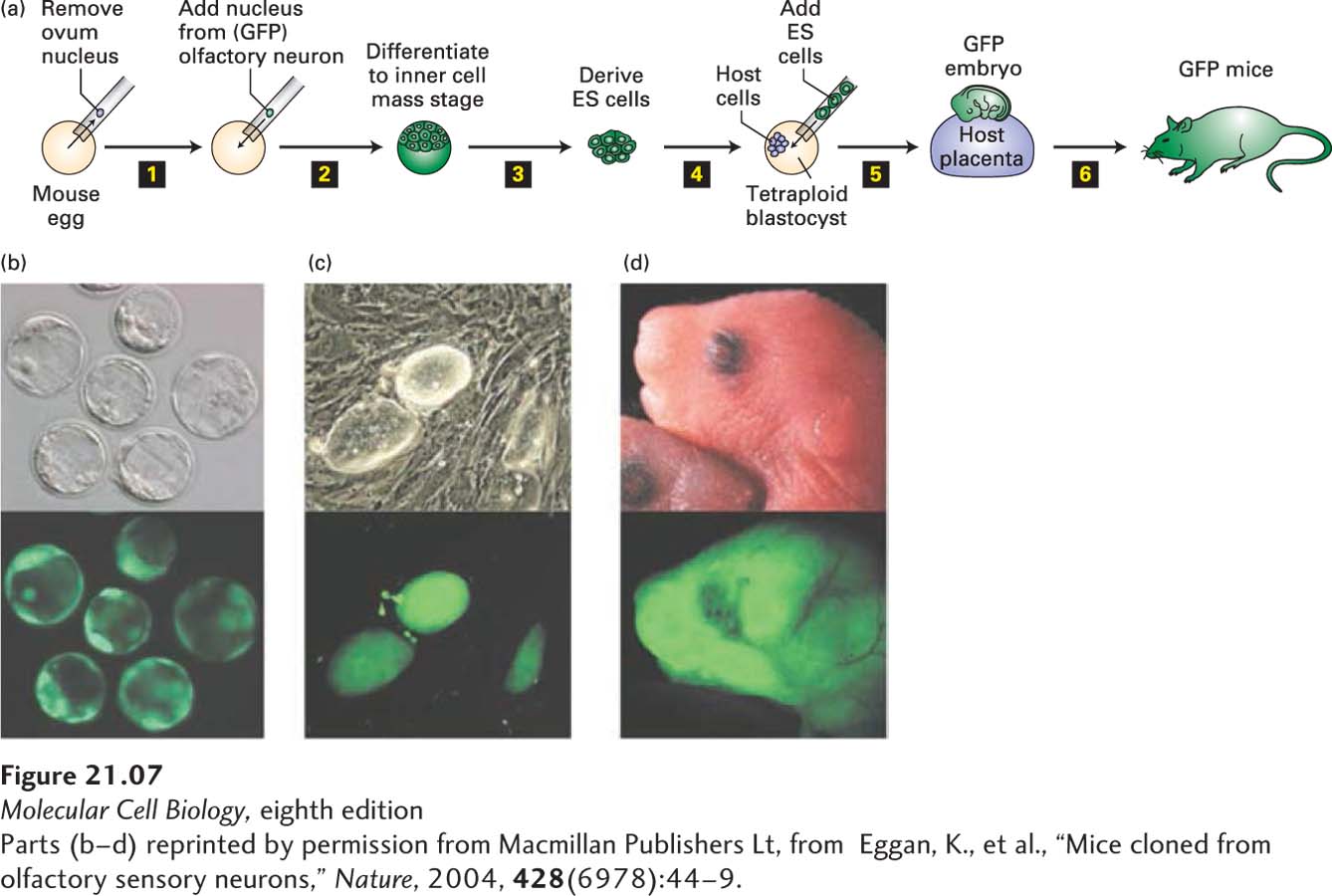Animal Cloning Shows That Differentiation Can Be Reversed
Although different cell types may transcribe different parts of the genome, for the most part the genome is identical in all cells. Segments of the genome are rearranged and lost during development of the T and B lymphocytes of the immune system from hematopoietic precursors (see Chapter 23), but most somatic cells appear to have an intact genome, equivalent to that in the germ line. Evidence that at least some somatic cells have a complete and functional genome comes from the successful production of cloned animals by nuclear transfer. In this procedure, often called somatic-cell nuclear transfer (SCNT), the nucleus of an adult somatic cell is introduced into an egg whose nucleus has been removed; the manipulated egg, which contains the diploid number of chromosomes and is equivalent to a zygote, is then implanted into a foster mother. The only source of genetic information to guide development of the embryo is the nuclear genome of the donor somatic cell. The low efficiency of generating cloned animals by SCNT, combined with a high frequency of diseases such as obesity in the animals that are cloned, however, raises questions about how many adult somatic cells do in fact have a complete functional genome and whether those that do can be completely reprogrammed into a pluripotent undifferentiated state. Even the successes, such as the famous cloned sheep “Dolly,” have some medical problems. Even if differentiated cells have a physically complete genome, clearly only parts of it are transcriptionally active (see Chapter 9). A cell could, for example, have an intact genome, but be unable to properly reactivate specific genes due to inherited chromatin epigenetic states.
Further evidence that the genome of a differentiated cell can revert to having the full developmental potential characteristic of an ES cell comes from experiments in which olfactory sensory neurons—postmitotic cells that normally will not divide again—were genetically marked with green fluorescence protein (GFP) and then used as donors of nuclei (Figure 21-7). When the nuclei from differentiated olfactory sensory neurons were implanted into enucleated mouse oocytes, a small fraction of them developed into blastocysts that produced GFP. The blastocysts were used to derive ES cell lines, which were then used to generate mouse embryos. These embryos, derived entirely from olfactory sensory neuron genomes, formed healthy green-fluorescing mice. Thus, at least in some cases, the genome of a differentiated cell can be reprogrammed completely to form all tissues of a mouse.

EXPERIMENTAL FIGURE 21-7 Mice can be cloned by somatic-cell nuclear transfer from olfactory neurons. (a) Procedure for generating cloned ES cell lines using nuclei from olfactory sensory neurons and using them to generate cloned mice. Step 1: A nucleus from an olfactory sensory neuron isolated from a mouse that expressed green fluorescent protein (GFP) only in its olfactory neurons was used to replace the nucleus of a mouse egg, and the resultant zygote was cultured to the blastocyst stage (step 2). The ICM cells, all of which were clones of the original olfactory sensory neuron, and all of which expressed GFP, were used to generate lines of ES cells (step 3). Step 4: These ES cells were injected into a tetraploid blastocyst. Step 5: When the blastocyst was transplanted into the uterus of a pseudopregnant mouse, the tetraploid cells from the host blastocyst could form the placenta (gray), but not the embryo proper; therefore, all of cells in the embryo proper and in the mouse that developed from it expressed GFP (step 6). (b–c) Bright-field (top) and fluorescence images (bottom) of (b) nuclear-transfer blastocysts and (c) the ES cells that were isolated from the ICM. (d) A control 12-hour-old mouse (top) and a mouse cloned from an olfactory sensory neuron, all of whose cells expressed GFP (bottom).
[Parts (b–d) reprinted by permission from Macmillan Publishers Lt, from Eggan, K., et al., “Mice cloned from olfactory sensory neurons,” Nature, 2004, 428(6978):44–9.]
